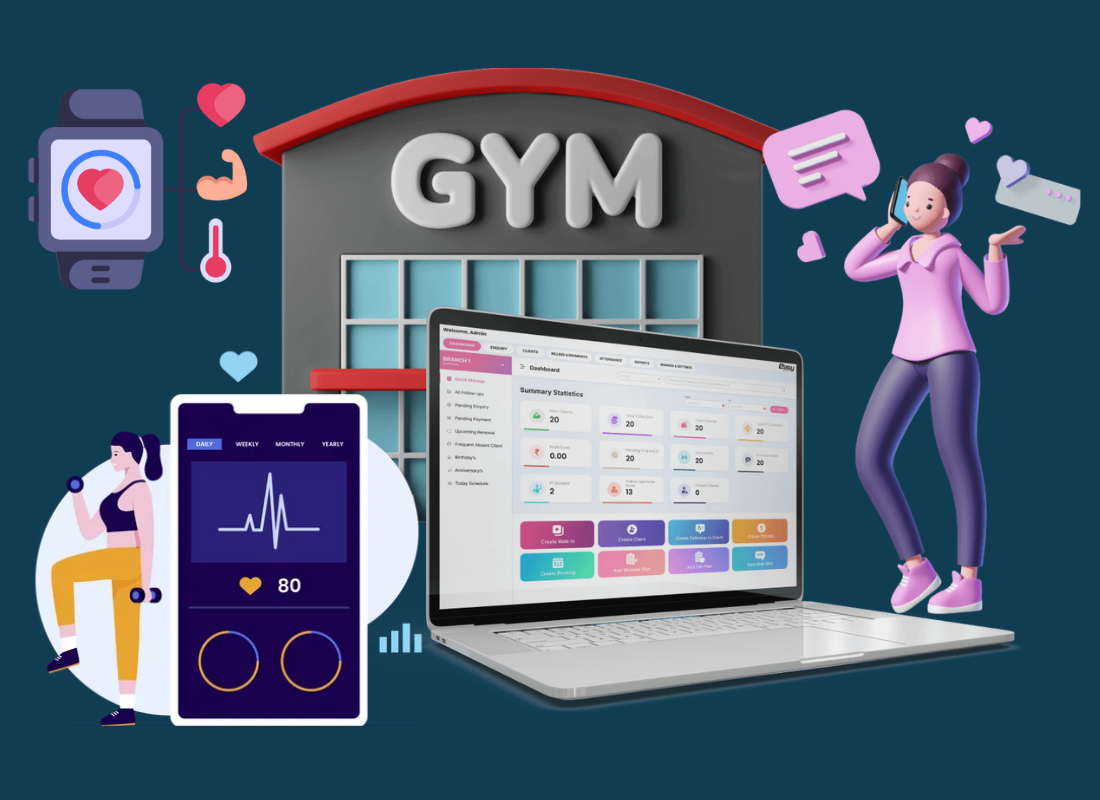Project Management Software has revolutionized how teams collaborate, communicate, and execute projects. Trello, Asana, and Jira are popular tools offering unique features and benefits. By choosing the right tools, integrating them with other solutions, and following best practices, teams can significantly enhance their management capabilities and achieve successful project outcomes.
You might be involved in building a website for a client, managing the steps or tasks involved in the project, and collaborating with your team. Well, you would know the importance of such tasks already. The real question is how to do it… A professional project management software answers this question. It helps bring together communication tools, file sharing, and task scheduling.
As well as set business deadline monitoring and reporting within a single software application that multiple teams and departments can utilize. Regardless of the scale of your business, your company can leverage the advantages of project management software services. Businesses use this popular tool to streamline their operations and achieve project goals on time and within budget.
In other words, project management software is a virtual workspace that works in real time, helping team members focus on larger objectives. In this blog post, we’ll talk about project management software, its features, cost, and how to choose the right application tools that best fit your needs. So, without much further ado, let’s dig in! We’ll start with the definition…
Understanding What Project Management Software Entails In Business Tasks
On the one hand, business management is the process of leading the workplace team to achieve all project goals within the given constraints. As a rule of thumb, this information is usually described in project documentation and created at the beginning of the development process. In reality, the primary limitations of any business management process are scope, time, and budget.
On the other hand, we can also consider the secondary challenge — how well and effectively to optimize the allocation of necessary inputs and apply them to meet pre-defined objectives. A project is a temporary and unique endeavor designed to produce a product, service, or result with a defined beginning and an end. So, to streamline the business management tasks, you’ll need a tool.
To enumerate, Project Management Software is an application-based toolkit that has the capacity to help plan, organize, and manage resource tools and develop resource estimates. Notwithstanding, depending on the sophistication of the application software, it can manage estimation and planning, scheduling, control control, and manage budgets. But there is still more that the software offers.
With project management software, team members can access a portal to obtain information, communicate with each other, and track the status of their assignments. This improves transparency, accountability, and collaboration, ultimately improving productivity and project success. Numerous PC and browser-based project and contract management software tools are available.
Basic Features:
- An Intuitive Dashboard: The dashboard displays assigned tasks for each employee and their corresponding due dates.
- Scheduling And Deadlines: Project managers can use the dashboard to quickly evaluate the work assigned to team members and incorporate new tasks into their daily schedule without overloading or distracting them from other business tasks.
- Ability To Assign Roles: It allows assigning team members to each task, ensuring everyone knows their project roles.
- Seamless Collaboration: It provides remote collaboration and employee communication tools, facilitating teamwork.
- Document Files Upload: Secure file sharing is an integral part of most project management platforms, allowing team members to quickly and safely share important documents, information, and assets.
- Business Project Templates: Many programs offer customizable templates to suit the specific needs of your business.
The most common project management software type is scheduling tools — which are used to sequence project activities and assign dates and resources to them. The detail and sophistication of a schedule produced can vary considerably with the project management methodology used, the features provided, and the scheduling methods supported. The cost of software is also vital.
It can significantly vary depending on the pricing structure and tiers, ranging from free entry-level services to premium options that cost hundreds of dollars monthly. Certain vendors may charge monthly per user, while others offer different subscription tiers with varying user limits. Sometimes, lower-priced software applications may provide more functionality than higher-priced options.
How To Determine If Your Business Needs A Project Management Software Application
Of course, tracking employees’ progress, their working hours, and other financial matters is a difficult task. Project management software provides a time-tracking application. This tool tracks employees’ attendance, their working hours, leaves, or vacations and provides employees with easy access to this data. It results in boosting employees’ work potential and trust in the company.
When assessing the financial investment required, it’s essential to consider the expenses related to training staff on the software and the cost of switching to a new application. It may not be the best solution for routine tasks. For instance, while employing software to configure a computer network could be beneficial, using the same to maintain the web might be more challenging.
The tricky questions are:-
- First, do you have a definite start date?
- Second, do you have a clear deadline?
- Third, do you understand your objectives well during the project timeline?
- Fourth, who will be involved in the project?
Project management software is necessary when a company works with multiple individuals or business units, whether internally or externally, to accomplish tasks involving various deliverables or creative components. In addition, it also helps in resource allocation, collaboration software integration, communication, decision-making, quality management, and time management.
As well as documentation or administration systems. A practical software tool also eliminates the risk of business errors or mistakes. An excellent digital project management software solution can benefit the manager and the company. However, if you notice any of the following issues in your business, it may be a sign that you require project management software.
Consider the following:
- Projects are frequently delayed due to poor email etiquette,
- Work gets lost in team members’ inboxes.
Businesses involved in finance( say corporate credit cards, disbursal, vendor payment solutions, etc.), e-commerce(B2C companies), and banking specifically suffer from the above problems due to bureaucratic delays. Technically, various project management methods can be applied to any project. It is often tailored to a specific project type based on size, nature, industry, or sector.
The top-rated project management software enables you to save and track numerous projects concurrently, allowing you to keep a tab on deadlines and the progress of each team member. All your tasks can typically be stored in a single platform, where every employee can access all the information they need to carry out their specific responsibilities.
The Most Notable Project Management Software Pros And Cons In Business
The starting point of most software that empowers the project management process is an online dashboard that acts as a central hub. Users can create new projects and manage existing ones from the dashboard. Reporting dashboards are often shareable with the entire team, ensuring everyone can access essential projects and tasks. Learn more about Project Management Software below:
Usually, the software allows users to create projects and tasks directly within the dashboard. In some other cases, the creation of a project may require approval from a supervisor before it can begin. Once a project is created, tools are available for organizing and coordinating specific tasks and ensuring accountability for completing assignments on time and to the expected standard.
One significant benefit of project management software is that it gives managers complete control over project direction. They can easily reassign work or rearrange tasks to ensure more equitable assignment distribution among team members and better resource management. These application software tools enable remote collaboration and facilitate meeting deadlines.
As a result, the assigned tasks and responsible team members can be viewed easily, making coordinating and delegating work easier. Today, most project management software has been implemented as a program that runs on each user’s desktop. In addition, some software programs also offer built-in chat applications that allow instant and direct collaboration among teams.
The Key Advantages:
- Utilizing a project management platform with a central location for tasks and files lets your team easily access and view any added jobs. Assigning tasks to specific employees will ensure they appear on their dashboards, providing transparency for each task.
- This eliminates the need to manually ensure that everyone has received the work and individually alert them when a project is finished. The streamlined approach saves time and effort, ensuring all group members are informed and up-to-date.
- Project management software can facilitate remote work by serving as a virtual office space for your team. It provides a centralized location where employees can access their assignments, submit deliverables, and seek clarification.
- Additionally, teams can update their progress, creating a sense of real-time collaboration despite physical distance. This makes it easier for employers to manage a remote workforce, ensuring tasks are completed efficiently and effectively.
- Project Management Tools can provide automated reporting that offers a comprehensive overview of a project’s progress. These reports can help you identify areas requiring attention and plan meaningful steps to achieve project goals. Without such tools, extracting and interpreting project data could be a tedious and time-consuming process.
While project management software offers numerous benefits to teams, it can also have certain limitations that may hinder your productivity or efficiency in some ways. Most project managers refuse to use digital solutions because they find them challenging to understand and operate. It’s not a disadvantage but a lack of awareness and knowledge, requiring simple tools.
The Main Disadvantages:
- The main drawback is the price. Small-scale business owners consider it an extra burden to their budget and ignore that this single investment can help their business double the revenue growth in half time.
- Project management software may be overly complicated for small tasks that require minimal effort. Tasks such as creating a job, adding information, and taking other steps may take as much time as the actual task.
- The learning curve associated with some project management platforms can challenge users, particularly those less comfortable with technology. Even if you opt for a platform that is known for its user-friendly interface, some employees may still face difficulties navigating it. However, the benefits of using a user-friendly platform far outweigh the initial learning curve.
- A quality project is usually time-constrained, often constrained (by funding or staffing), and undertaken to meet unique goals and objectives. Precisely to bring about beneficial change or added value.
Equally important, the temporary nature of projects contrasts with business as usual (or operations) — which are repetitive, permanent, or semi-permanent functional activities — to produce products or services. Realistically, managing distinct production approaches requires developing special technical skills, adequate knowledge, and sufficient business management strategies.
How To Choose The Right Project Management Software For A Business
According to a recent World Business Organization survey, about 70 organizations use project management software and reap fruitful results. However, some business owners, mainly small-scale and beginners, are not ready to trust the needs of digital tools. They consider the implementation of digital tools a waste of time and money. It’s worth testing this approach and its effectiveness.
A project manager’s job is difficult because they must look after many tasks. The use of the right project management software tool takes their burden. Notwithstanding, it provides them with real-time analysis of work progress, resources, financial health, and ongoing market value of the company. Furthermore, it also helps managers to compare this report with their competitors.
Another notable feature to look out for when using digital solutions to manage a project effectively is that it should help in adequate budget and resource management. The tool must also provide real-time tracking of funding and resources, preventing expense overflow or budget shortage. Primarily, this report shows project managers can take immediate steps to avoid troubles.
Although most top-notch project management software applications offer the same features, each platform has unique attributes. Looking internally is more important than looking outside. Selection of a simple but effective tool and providing the workforce with proper training can help to solve the complexity issue. There are a few factors to note before choosing your software.
Including:
- Capacity: The requirements of a large enterprise are distinct from those of a small startup. Hence, evaluating each application and asking vendors the relevant questions is essential to ensure that it caters to your company’s unique needs.
- Scalability: As your project management requirements change, ensuring your chosen software can keep pace with your evolving needs is crucial. For instance, the platform’s file storage capacity may not increase as your company grows, or the pricing may become unaffordable if your team expands beyond a specific size.
- Performance: It is beneficial to recognize your existing project management challenges. For instance, you may struggle to provide timely client updates or communicate effectively with your team. You can select the software that effectively addresses your specific requirements by identifying your weaknesses.
- Technology: Good project management software is designed on the base of advanced technology, and the existence of a technical fault in them is a common practice. Usually, it happens due to mishandling, carelessness, and wrong selection. Selecting a credible platform or tool like BQE Core, proper care, and maintenance is the best solution to this problem.
The Bottom Line:
Project management software and other applications are growing to fill the gap between project management teams and the advanced corporate world requirements. It provides the workforce with all crucial tools, tips, and tricks. Specifically for business managers to ensure the quality work of each deliverable within time/budget. Unfortunately, others don’t see its need.
Efficient, errorless, and timely completion of projects helps project managers win more projects, which results in the smooth and fast growth of the company. Therefore, project managers strive hard to ensure successful project completion. As well as have maximum projects in minimum time and within budget — for good workplace flow and projects admin. Thus, it’s resourceful.
It’s not just about the cost when considering new Project Management Software Tools for your business—it is rarely about the price. Instead, it is about efficiency. Considering how not having the software could hurt your business would be best. Without project management software, you might encounter issues like miscommunication, redundancy, and wasting time and money.
But with the right platform, you can take your workflow to the next level and get many great benefits. To get the best application software, you must examine its core features, benefits, and drawbacks. So it’s worth your time. Don’t doubt it! Good Luck!
Author Bio: Ramitha Ramesh
Ramitha Ramesh is the editor at Karbon Business, renowned for her expertise in SEO content marketing strategy for a diverse clientele across the US, UK, and India. With a penchant for exploring the fast-paced realm of finance, business, and marketing, her blog is a treasure trove of insights that offer unique perspectives on the latest trends and developments in the industry. Finding nirvana in food, fun, and travel, she is on a mission to counter the infodemic amidst digital chaos.



